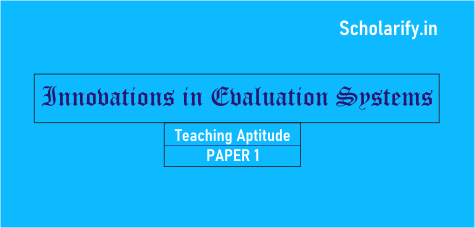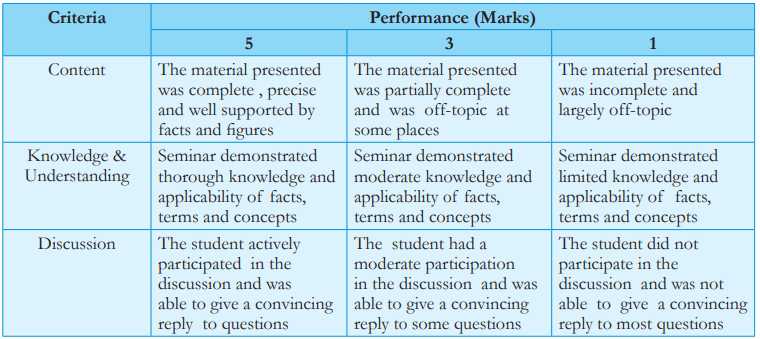
Innovations in Evaluation Systems
Innovations in Evaluation Systems: Traditionally, many teachers have evaluated their students’ knowledge by giving examinations and papers, often only at the middle and end of the quarter. As a result, a professor lecturing to a large introductory class might not recognize until final exams are finished that students consistently confused the essential and closely related ideas.
Some Important Innovations in Evaluation Systems
Concept maps
Concept maps provide a visual representation of connections between concepts that students have learned. These concepts are connected by directional, labeled links to show the relationships between them. Concept maps are excellent tools that can provide instructors with a formative assessment of students’ learning and misunderstandings after the students were introduced to the new material. For example, the instructor can post an incomplete concept map where students are asked to fill in the blanks to build a complete map, which is then submitted to an instructor in class or via an online dropbox.
Concept Tests
Concept Tests are multiple-choice questions designed to test the understanding of a single concept. They are effective at identifying common student misconceptions surrounding traditionally difficult concepts in science and engineering and have been shown to enhance student comprehension of fundamental concepts. The questions are posed during the lecture immediately after the key concept has been described or discussed.
Students work independently to arrive at an answer and then try to persuade their neighbors in the lecture room that they are correct. Finally, all the students offer their answers. The instructor confirms the correct answer, and the class can discuss why it is correct and how some students were misled. This form of peer instruction is offering students and their instructor insight into how well they understand the various key concept and allows them to identify and address popular misconceptions.
ePortfolio
An ePortfolio is an online space where students can store and organize artifacts that they have produced in the course, such as written assignments, images, videos, and so on. They then use the ePortfolio to reflect on their learning experiences. An ePortfolio requires students to pause and reflect on their learning, often by making explicit connections between different learning experiences.
This process deepens their learning and has the added benefit of helping them to chronicle their learning: they can look back on earlier work in their ePortfolio and readily see how much they have learned and how far they have progressed in the course. An ePortfolio helps students to “see” connections within various components of a course, or among their various courses.
Podcasts and Vlog
A podcast of vlog project encourages students to take their identifications, analyses, reports, diagrams, etc. to a real-world, digital level by creating a visual/verbal file for submission that activates and authenticates their learning. This can be done individually or collaboratively.
Podcasts and vlogs are similar to poster presentations in terms of the content-based orientations of them, yet they take it to a different level by creating and facilitating an extension of the classroom for audiences beyond the students’ immediate classmates and immediate teacher. This type of assignment encourages professional writing and presentation processes (such as oral and visual communication skills), but it also fosters networking and the building of connections for the students and their subject matter.
Talk Show Performance
A Talk Show Performance is an authentic version of the more traditional in-class presentation as it directs students to take on and embody their learning for an interactive, live, or record discussion. It can be character-based (i.e., students taking on and acting as an individual in their discipline would, talking about the issues, analyses, diagrams, etc. and answering questions as this person would) or it can be self-based (i.e. students perform as themselves, presenting the materials and answering questions as they themselves would be based on their developing knowledge).
Minute Paper
Pose one to two questions in which students identify the most significant things they have learned from a given lecture, discussion, or assignment. Give students one to two minutes to write a response on an index card or paper. Collect their responses and look them over quickly. Their answers can help you to determine if they are successfully identifying what you view as most important.
Artificial Intelligence
In AI assessment, a software system infers problem-specific rules for automated scoring from examples of instructor grading of student assignments. AI assessment is also considered one of the innovations in evaluation Systems
Initially, AI techniques are applied to learn how an instructor grades a problem. The instructor evaluates a sample set of student responses, and the system creates a computer model incorporating rules it inferred about the instructor’s grading decisions. The model is then used to grade other students’ work.
Such techniques are applied to student work in a number of disciplines, for example, to mathematical problem-solving, to programming in computer science, and increasingly to essays.
The strengths of AI assessment are efficiency, consistency in applying the same criteria across students, and immediate and detailed feedback on performance.
Today, AI assessment is most useful as one part of an assessment process and for enhancing learning, rather than making final, authoritative, high-stakes decisions about student performance. Key considerations are sufficient transparency of the rules applied, human scoring establishing the validity of machine-generated scores, and ongoing quality control.
Just-in-time Teaching
Just-in-time teaching actively engages students in learning new material and gives the instructor information on students’ existing knowledge before teaching on the topic begins.
First, students respond to a Web-based set of questions, usually open-ended thought questions or exercises, about new material before it is covered in class. After reviewing student submissions, the instructor adjusts teaching activities to meaningfully address student shortcomings and misconceptions – just in time in the learning process.
Through these warm-up questions and exercises, students and instructors are primed for a more productive instructional experience. In-class and out-of-class learning activities become more interwoven and pertinent, enhancing learning for students whatever their initial level, motivating active learning, and improving classroom climate.
This interactive technique also provides baseline assessment of the state of students’ initial understanding of the content to be learned, including misconceptions. Such baseline information can be compared to similar information after instruction not only to assess individual student learning, but especially the effectiveness of instruction.
Assessment Rubrics
A rubric for assessment, also called a scoring guide, is a tool used to interpret and grade students on any kind of work against criteria and standards. An assessment rubric provides the means to increase objectivity in assessment and reduce subjectivity; presents a clear expectation on the assessments, and relates it to learning outcomes; ensures consistency, transparency and fairness in the marking process across course instructors for the same assessment type; efficiently grades or marks many assessments for a large group of students; defines clear guidelines for moderation; and provides more objective data for analytics. So, Assessment rubrics can be counted as one of the innovations in evaluation systems.
Usually in the form of a grid, a grading/ marking/ scoring rubric combines the elements of performance, criteria and descriptors to create an assessment tool for the course instructor.
The assessment criteria define the characteristics or traits to be judged which should be derived from the course learning outcomes and indicate what is expected to be demonstrated.
Level of performance is the rating or measure on the degree of achievement on a particular criterion as specified by the rubric, i.e. excellent/good/satisfactory/poor etc.
Descriptors identify the qualities required to demonstrate achievement of each level of performance for each criterion. Listed in the form of short explanations, they provide guidance on the actual judgement on the assessment to match students’ performance.
An illustration below provides a few criteria, levels of performance and descriptors

Use of Technological Interventions
With the proliferation of different types of access devices, especially mobile access devices, technology has the potential to augment traditional classroom practices and revolutionize learning and evaluation methods. Technology, in fact can be an important driver to enable lifelong learning. Learning and engagement of students is facilitated by use of technology through several modes such as synchronous learning, semi-synchronous learning, blended learning, collaborative learning, flipped classroom etc.
MOOC’s, especially provided through SWAYAM, are a window of opportunity for lifelong learning and are offered through technology-based platforms. Learning management systems (LMS) are used by institutions to integrate the entire teaching, learning and evaluation process.
The Learning Management System may be used by higher educational institutions to deliver academic content in blended form and to assess learning through thesis, assignments etc. Open source learning management systems such as Moodle, Edmodo may be used for posting content in the form of videos, audios, e-learning modules, live class sessions etc. Use of plagiarism detection software is highly recommended in order to check originality of content.
In the conduct of examinations, universities face tremendous challenges such as need for trained manpower, distribution of question paper without delays and errors, delays in evaluation of answer scripts, lack of infrastructure to conduct examinations at a large scale, non-availability of faculty members for assessment, security issues faced during paper setting and paper distribution, tampering of certificates and answer scripts etc.
For a typical examination department of an institution, automation is required right from registration of student to convocation through an integrated system. In fact, steps must be taken to implement a complete examination management system that considers the complete life cycle of examination process. The use of technology will reduce dependency on human intervention and be error free.
The following functions have to be automated:
✔ registration of students and generating unique PRN,
✔ filling up of examination form,
✔ generation of seat numbers and admit cards/hall tickets,
✔ preparation of a list of paper setter,
✔ use of question bank system to draw question sets, question paper generation,
✔ online distribution of question papers on the day of examination with a system of encryption,
✔ barcode system for answer books (this will eliminate issues related to errors, avoid malpractices, etc.),
✔ digitization of answer scripts and onscreen evaluation of answer sheets,
✔ tracking of students’ performance,
✔ Marks submission through online software,
✔ viewing of results through an online system,
✔ online verification and revaluation system,
The methods and techniques mentioned above can be considered as Important Innovations in evaluation systems. There are some other innovative way to evaluate the learners. Please go through internet and search or refer some other e-contents, and books.
Refs.
https://www.ugc.ac.in/e-book/EVALUATION%20ENGLISH.pdf
https://teachingcommons.stanford.edu/resources/teaching/evaluating-students/assessing-student-learning
https://www.queensu.ca/teachingandlearning/modules/assessments/31_s4_01_intro_section.html
Related Topics:
UGC NET Syllabus (Updated): Paper 1 and 2 (Download)
Solved Question Papers of UGC NET Paper 1
UGC NET Study Materials for Paper 1 (Download PDF)
M Phil and PhD Fellowship